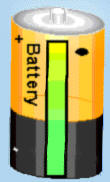 Many batteries now come with a battery tester. How does
a battery tester work?
Many batteries now come with a battery tester. How does
a battery tester work? Many batteries now come with a battery tester. How does
a battery tester work?
Many batteries now come with a battery tester. How does
a battery tester work?
Answer:
A battery tester is a dark, brown strip. If each end is pressed against the poles of a
battery, a part of the strip turns yellow. The length of the yellow portion of
the strip depends on the condition of the battery. If
you look on the back side of the strip, you will see a wedge-shaped piece of
conducting material. The strip itself is a
liquid crystal. This liquid crystal changes
color at approximately 115 degrees Fahrenheit. You can show this by
putting it in a glass of hot water.
If you press the ends of the conducting wedge against
the poles of a battery a current will flow through the wedge. The
current is given by Ohm's law, I = V/R, where
R is the total resistance of the wedge.
The resistance per unit length, however, is not
constant. It is higher in the narrower portion
of the wedge and lower in the wider portion. The
power dissipated per unit length, which is equal to the square of the current
times the resistance per unit length, is therefore largest in the narrowest
portion of the wedge. The wedge heats up more
here. Heat causes the liquid crystal strip to
turn yellow.
A new battery produces a large enough current to even
heat up the wide portion of the wedge and turn the liquid crystal above it
yellow. As the battery gets used up, the current
decreases and the length of the yellow portion decreases as only the narrow
parts of the wedge get hot enough to turn the crystal above yellow.